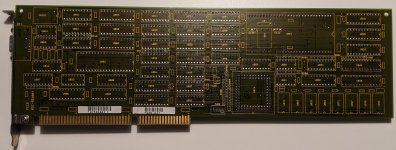hanshuebner
Member
Hello,
a friend gave me this ISA card:


Peter Schranz suggested that it could be manufactured by ROI (Rolf Obler Industrieelektronik), but that company seems to have folded before the age of the Internet. He also mentioned that it might be possible that the serial port is likely to be wired as the DCJ11 console and the card could be made to boot into ODT by manipulating the jumpers correctly. JU02 connects to ISA interrupts, and changing JU01 does not cause anything to appear on the serial port, however. I tried two different terminals with all four jumper combinations, and I've sent a break with each of them to see whether that'd bring up ODT.
The card uses a lot of programmable logic parts - GALs, but also two interesting Am29CPL 154H Field-Programmable Controllers. To me, that seems to make reverse engineering pretty much a lost cause. I wonder whether anyone here has seen the board before or has other ideas how one could bring it back to life. Using it as a building block for a little PDP-11 based FORTH would be a fun exercise to me.
Thanks!
Hans
a friend gave me this ISA card:


Peter Schranz suggested that it could be manufactured by ROI (Rolf Obler Industrieelektronik), but that company seems to have folded before the age of the Internet. He also mentioned that it might be possible that the serial port is likely to be wired as the DCJ11 console and the card could be made to boot into ODT by manipulating the jumpers correctly. JU02 connects to ISA interrupts, and changing JU01 does not cause anything to appear on the serial port, however. I tried two different terminals with all four jumper combinations, and I've sent a break with each of them to see whether that'd bring up ODT.
The card uses a lot of programmable logic parts - GALs, but also two interesting Am29CPL 154H Field-Programmable Controllers. To me, that seems to make reverse engineering pretty much a lost cause. I wonder whether anyone here has seen the board before or has other ideas how one could bring it back to life. Using it as a building block for a little PDP-11 based FORTH would be a fun exercise to me.
Thanks!
Hans
